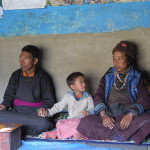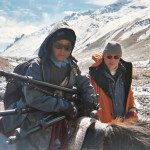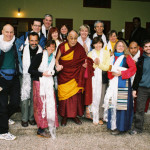Journey From Zanskar Warriors Forum – Additional Information and Downloads
[expand title=”In the Press”]
Heartbreaking. Shines a light on a place and a way of life that are rapidly changing. NEW YORK TIMES
Extraordinary, remarkable. VILLAGE VOICE
Effective suspense and compassion. NEW YORK MAGAZINE
Wondrous… A perfect, and highly imaginative complement to Hoop Dreams… It seems certain to speak to millions. Pico Iyer, author: “The Open Road: The Global Journey of the Fourteenth Dalai Lama”
Beautiful, powerful, and heart-warming… I hope the film will bring much needed assistance to the noble Zanskari people. Robert Thurman, Founder, Tibet House, NYC
Inspiring. NEW YORK DAILY NEWS
Compelling. NATIONAL POST (Canada)
Heart-breaking and action-packed. TORONTO GLOBE AND MAIL
Seat-of-the-pants filmmaking. NOW Magazine
Gripping… Fascinating… The sight of tiny children making their way across the frozen land is an indelible image. Cleveland Plain Dealer
Audiences will definitely root for these kids and feel for their parents. The Epoch Times
Compelling viewers to care about not only the outcome of this particular journey, but about the fate of Zanskari culture. SEE Magazine
A tale of sacrifice and devotion… This is a film that really does put our lives into perspective. Straight.com
- NOVEMBER 28,2011 – Journey from Zanskar: Frederick Marx interview
- SEPTEMBER 21, 2011 – The Village Voice, Andrew Schenker, “Well Worth the Trip: Trek to Keep Tibetan Culture Alive in Journey from Zanskar”
- JANUARY 21, 2011 – Martin Dunphy, Vancouver, B.C. online magazine Straight.com
- OCTOBER 5, 2010 – Pier Marton, Washington University, Film and Media Studies Program” “Journey From Zanskar”” http://piermarton.com
- OCTOBER 4, 2010 – SilkThangka.com, Leslie Rinchen-Wongmo “Journey from Zanskar to Sun Valley and beyond”” silkthangka.com
- SEPTEMBER 29, 2010 – SF 360, Michael Fox””Local Filmmakers Pour into Mill Valley”” www.sf360.org
- SEPTEMBER 15, 2010 – Duke City Fix, RigDzin Dharma Center””JOURNEY FROM ZANSKAR Duke City Fix”” www.dukecityfix.com
- SEPTEMBER 14, 2010 – LOCAL-IQ, by rigdzindharma””Journey From Zanskar-meet the director”” www.local-iq.com
- AUGUST 29, 2010 – Daily News & Analysis (DNA), Lhendup Gyatso Bhutia””Frederick Marx’s Himalayan Odyssey”” www.dnaindia.com
- JULY 15, 2010 – SEE Magazine, Alistair Henning “To School, Both Ways Uphill: Perilous journey makes for compelling documentary” www.seemagazine.com
- JULY 9, 2010 – The Houston Chronicle, Zen T.C. Zheng “Moving mountains for a better life: Gripping documentary tells story of Tibetan Buddhist children on perilous journey across Himalayas to school” www.chron.com
- JULY 9, 2010 – The Regina Leader-Post, Chris Knight”‘Journey’ is Compelling, Inspiring” www.leaderpost.com
- JUNE 22, 2010 – EYEWEEKLY.com, Kieran Grant “Journey From Zanskar” www.eyeweekly.com
- JUNE 18, 2010 – Metro News, Phil Brown “Journey From Zanskar: An Ode to Human Will” www.metronews.ca/
- JUNE 17, 2010 – The Toronto Star, Jason Anderson “Journey From Zanskar: The Road to Redemption” www.thestar.com
- JUNE 17, 2010 – National Post, Chris Knight “Journey From Zanskar” www.nationalpost.com
- JUNE 17, 2010 – The Globe and Mail, Jennie Punter “Journey From Zanskar: A long, hard way to get to school” www.theglobeandmail.com
- JUNE 17, 2010 – NOW Magazine, Norman Wilner “Journey From Zanskar: Moving Story” www.nowtoronto.com
- MAY 27, 2010 – The New York Times, Tammy La Gorce “A User-Friendly Film Festival” www.nytimes.com
- MAY 12, 2010 – The Epoch Times, Joe Bendel “Documentary Review: ‘Journey From Zanskar: a Monk’s Vow to Children'” www.theepochtimes.com
- MAY 4, 2010 – New York Daily News “‘Journey From Zanskar – A Monk’s Vow To Children’ at the Rubin Museum of Art” http://events.nydailynews.com
- MAY 1, 2010 – NBC New York “‘Journey From Zanskar’ at the Rubin Museum of Art” http://events.nbcnewyork.com
- APRIL 1, 2010 – CineSource, David L. Brown “Survey New Bay Area Docs” www.cinesourcemagazine.com
- MARCH 16, 2010 – Cleveland.com, Julie Washington, The Plain Dealer “‘Journey from Zanskar’ documents the quest for education at the top of the world” www.cleveland.com
- JANUARY 7, 2010 – Colorado Springs Independent, Kirsten Akens “Traveling Buddha- Hoop Dreams Filmmaker tackles Himalayan Trek in a sneak-peek documentary showing at CC” www.csindy.com
- JANUARY 6, 2010 – Colorado Springs Gazette, Mark Barna “‘Hoop Dreams’ filmmaker screens new documentary at CC” www.gazette.com
- DECEMBER 9, 2009 – The Huffington Post, Esther J. Cepeda “One Chicago Cellist Plus One Dalai Lama Equals a World of Compassion” www.huffingtonpost.com
- JUNE 18, 2009 – The Huffington Post, Esther J. Cepeda “Hoop Dreams Filmmaker Makes The Journey From Zanskar Via Chicago” www.huffingtonpost.com
[/expand]
[expand title=”Calendar”]
Talks by Frederick Marx and related events will be listed on our Warrior Films Events page.
[/expand]
[expand title=”Distribution”]
Most rights worldwide are presently still available.
DVD copies are now available directly from our Warrior Films Online Store.
Now available in France and French-speaking Europe and Africa. Visit the French site here.
To license the film for TV, DVD sale, or other, please contact: [email protected]
[/expand]
[expand title=”Technical Information”]
Journey From Zanskar is available in HDCam (NTSC and PAL), Digi-Beta (NTSC), digital file (NTSC and PAL), Blu-Ray (NTSC), and DVD.
16×9
Stereo
Color
Languages: Zanskari, Tibetan, English, Hindi
English Subtitles
90 minutes
[/expand]
[expand title=”Director’s Statement”]
“How far would you go to save your dying culture?”
“Sometimes you have to give up your children in order to save them.”
Those two statements serve as “taglines” for JOURNEY FROM ZANSKAR – each of them describing the heart of the film. But the film didn’t start out with those as the central ideas. It took a long journey to arrive at the simplicity of those two statements.
JOURNEY FROM ZANSKAR began in 2004 when an old friend called to ask for my help in supporting the Stongde monks of Zanskar. “Zanskar? Where the hell is that?” Even the name seemed forgotten. An Indian finger poking into the heart of central Asia, bounded by Tibet (China) on one flank and Pakistan on the other, Zanskar almost reaches Afghanistan. Bounded by towering Himalayan mountains, this high altitude desert sits on a valley floor of 12,000 feet. “Little Tibet” it’s sometimes called. “Mountains? Buddhists? Dying culture?” I was in.
In April 2004 I sat around my kitchen table in San Francisco with Barry Weiss and Curt Jones – two of the key principals who originated the project. We talked through an initial plan to film Tenzin Choegyal’s long-awaited visit to the seven ancient monasteries of Zanskar in July. Better known as the youngest brother of the Dalai Lama, TC (as he is called) is recognized as the reincarnation of Ngari Rinpoche – the spiritual leader of all the monasteries of Western Tibet. As such, he is revered and beloved, despite his own skepticism on the subject. We were also hopeful that the Dalai Lama himself would visit Zanskar in August. Seemed like an auspicious time for a Zanskar story.
Like many of the best-laid plans, none of this ever happened. I arrived in Delhi in early July with my crew of one – cameraman Nick Sherman – and two helpers: Curt Jones and his stepson Christian Kakowski. For reasons still unclear to me, TC had cancelled his trip. It was a huge disappointment – not only had our story evaporated but, having learned a great deal about Ngari Rinpoche, I was really disappointed not to meet him.
Nevertheless, we flew to Leh, the capital of much better known Ladakh, and spent a few days getting acclimated, thinking about what else to shoot. We spent some time at Helena Norberg Hodge’s wonderful Farm Project – kind of a reverse Peace Corps. (Foreigners come there to get educated by the locals in organic farming and cooperative cultural practices.) Then we left relatively Westernized Ladakh for far more remote Zanskar. En route with Geshe Lobsang Yonten I learned that he planned to take 15 children to a Tibetan school in Manali that Fall by trekking overland through 17,000 foot Shinku Pass. “That’s our through-line!” I thought.
We started filming right away as Geshe Yonten and Lobsang Dhamchoe began visiting families who wanted to send their children away to school. Those moments with families are rich, complex, and absolutely heart-rending. As a parent, what would you discuss with a man who’s going to take one of your children away, possibly forever? Struggling even to feed your children, you certainly would want your child to have a chance at a better life. But at the price of not seeing them again for 10, 15, maybe 20 years? The monks themselves had been through a similar process – leaving home for 10 years while they were still kids. They knew the difficulties but they also knew what an education could do to change a life.
Following that first visit, Nick and I returned to India for the trek in early October. On our drive from Leh to Padum we confided all our fears to Geshe. It was a long list. There were dangers both for us and the kids – altitude, cold, dehydration, exhaustion… Smiling, he told us not to worry. Unlike Zanskari Buddhists who don’t seem to stress out about anything, we worried.
The story of the trek as it appears in the film is our story too. We were right there with them. We shared the uncertainties, the cold, the disappointments, the fears. At the same time we shared the beauty, the generosity and concern, all the good humor – these were our delights too. Since we didn’t have sufficient crew support, we had the fathers and monks help us carry gear; they served as production assistants. Our equipment and “crew” were rarely with us in the same place at the same time. Communication was also difficult, often impossible. Physically, I had more difficulties with the sub-zero temperatures, snow and elevation than Nick but we both managed pretty well–up to the day we attempted to cross the Pass.
Like Geshe, on that day I thought I was going to die. When we first set out that morning I was already struggling – slipping and falling, sweating, hyperventilating. Nick kept up with the lead party and shot everything he could. Thanks to him the turning point of the film was captured. He shot the pivotal scene when I wasn’t even there. I was further back than Geshe – huffing and puffing and hoping I’d make it over the Pass. The thought “I’m too old for this” was probably the most benign thought I had that day.
Five days later when, by jeep, we finally reached Leh, Nick flew back to the States and I became a one man crew. In addition to losing his visualizing talents, I lost my sounding board, confidante, and back-up crew. I also lost his Canon GL2 camera, which had become our A camera. All the footage from Leh onward was shot by me, much of it with the C camera – a cheap consumer handicam, because I couldn’t properly charge my batteries for the much better B camera – my JVC GY500. Ironically, the only battery problems we had on the whole trip were after we reached “civilization.” I ended up giving myself a camera credit in the film not because I shot 20% of the story but because I didn’t want Nick to take the heat for my crappy footage!
In Feb. 2005, we made a third trip to India to film the scene of the children meeting the Dalai Lama. Once in Dharamsala we didn’t know until the day before that it was actually going to be possible to meet with him. We had all of fifteen minutes to get the material I knew was going to be the capstone scene for the whole film. People ask me all the time what it was like to meet the Dalai Lama. I tell them I don’t know I was working!
One of our greatest challenges for the whole project turned out to be translation. During the filming in Zanskar, we never had an adequate translator with us. Not only could we not speak directly with the families and the kids, we never knew with certainty what was happening at any moment. Geshe and Dhamchoe filled us in as best they could, but their own limited command of English sometimes made our communication difficult. In hindsight, my biggest regret is that I didn’t learn Zanskari myself. I could have made a different film – highlighting the children more – and sharing more about their families and their back-stories.
Back in the U.S., it was also nearly impossible to find translators for the 45 hours of Zanskari footage. Little did I know when we began that only a handful of speakers in the world are fluent in both Zanskari and English. In the end, Geshe did the bulk of the translation himself while on a visit to the US. Through an elaborate game of telephone, he translated the spoken Zanskari into Tibetan. Then a Tibetan student translated each line from Tibetan into English, all the while writing down time codes. They also translated 20 hours of Tibetan and Hindi. This painstaking process took over a month.
So it was only in April of 2008 that for the first time I could sit down with complete transcripts of our footage and discover what it was we had actually shot almost four years before! What a delight! I made many discoveries that I had no idea existed in the footage. It was also fun to hear some of what Geshe and Dhamchoe had been saying about me and Nick!
Constructing the proper storyline took about a year, helped in no small way by co-editor Joanna Kiernan. I spent most of summer 2008 putting subtitles on hours of raw footage and editing the first string-out. In the Fall, Joanna edited the first rough cut, setting a basic structure for the story. Then from December onward I brought the film home. Due to the usual lack of finances we didn’t finish until October, 2009.
The journey that has been JOURNEY FROM ZANSKAR has been informed at every juncture by the wisdom, humor, and acceptance of Geshe Lobsang, Lobsang Dhamchoe, the gracious and joyful monks of Stongde monastery, and the amazing resilience of the people of Zanskar, from the youngest child to the oldest grandmother. They are true spiritual warriors! There were times in the two years prior to completion when, overwhelmed with anxiety and stress over how I was going to finish the film, I would drop my head to my desk and weep. The one thing that always pulled me through was the film itself. I would pick up the editing again and see Geshe laugh in the face of crushing disappointment, witness a starving mother weep bittersweet tears giving up her daughter for a chance at a better life elsewhere, hear the children sing while riding into a dangerous and unknown future, observe Yangjor help Jigmed’s blinded father cross a stream, watch Tsultim reach out to share with me his first ever taste of nuts. Their example fortified and inspired me. How could I not make this film?
[/expand]
[expand title=”Photos”]
- Frederick Marx riding the trail
- Frederick Marx and Tsultim with tripod
- Frederick Marx with the Stongde monks
- His Holiness the Dalai Lama with Frederick Marx and others involved in the project
[/expand]
[expand title=”Downloads: press kit and high-resolution images”]
Press Kit (7 MB)
Three Kids – high resolution image (66 MB)
Frederick Marx filming in mountains – high resolution image (250 MB)
[/expand]





